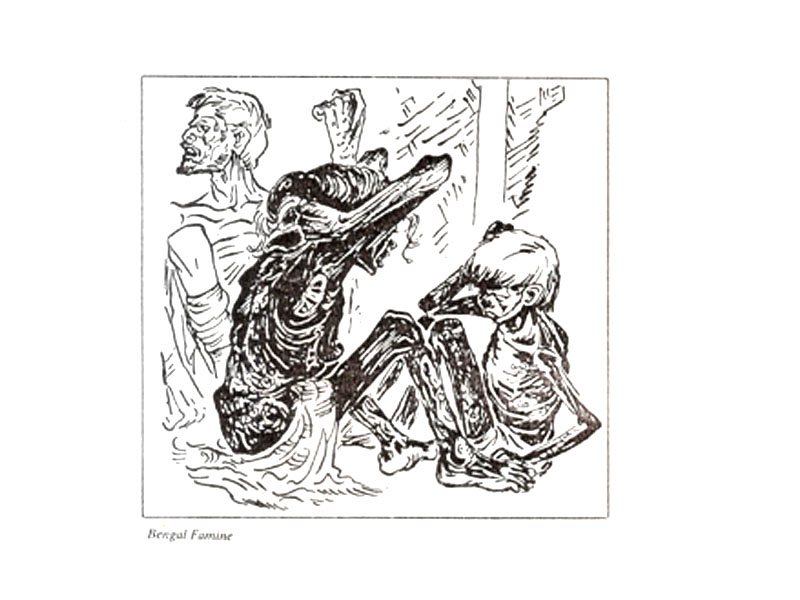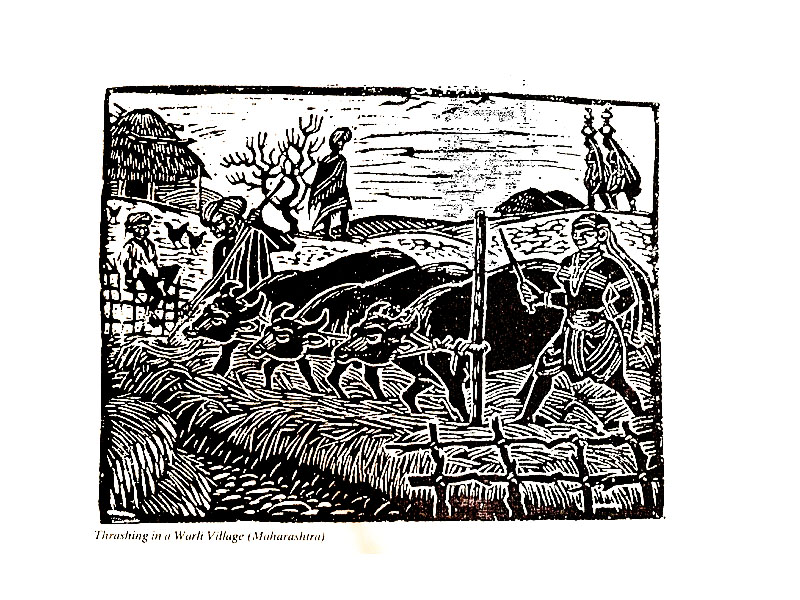In the history of contemporary Indian art Chittaprasad perhaps is hardly known. He lived almost a recluse in Andheri, a suburb of .Bombay, for thirty-two years.Chittaprasad worked and lived in Bombay until he died in Calcutta in 1978.His place was frequented by a handful of his close associates among whom only a few were artists. It is surprising that Chittaprasad’s works were never exhibited in Bombay. To my knowledge he had only two one man shows in India, one in 1964 (organised by a group called ‘Shilpayan’) and the last one in 1980 (after he died), organised jointly by the Chittabharati, an organization devoted to preserve the works of Chittaprasad, and the Department of Information and Cultural Affairs, Government of West Bengal. Both the exhibitions were held in Calcutta. Outside India Chittaprasad’s works were shown in U.S.S.R., Denmark, U.S.A., Mexico, Czechoslovakia and Tanzania.
Chittaprasad was born in 1915,in the District of 24 Paraganas, West Bengal He completed his schooling from Chittagong Municipal High School, which is now in Bangladesh. As a young boy he was encouraged and inspired by the village potters, painters and puppeteers.
This influence was so strong that throughout his artistic career he fell back repeatedly on the sources of the traditional and folk style. The other important thing to happen in Chitta’s life during this period was that it was in Chittagong where he first came in contact with the Bengal Famine Communist Party.He started doing sketch-portraits of the were years of great upheaval.The struggle for Independence national leaders as well as the British GI who were stationed in Chittagong and also started political posters.
But a little later he expressed his willingness to undergo proper art training. He came to Calcutta and tried to seek admission in the Government College of Art and Craft.But the Principal of the College demanded a written declaration that he would never actively participate in politics.Chittaprasad refused to oblige.Later Chittaprasad went to Santiniketan to seek admission in Kala Bhavan. He met Rabindranath Tagore and made a quick portrait of him at which Rabindranath was so impressed that he advised Chitta not to waste time in the art college and that he should continue his Sadhna in his own way.
Chittaprasad returned to Chittagong.
Chittaprasad moved to Calcutta in order to make a living an artist.Both at national and international levels these were years of great upheaval.The struggle for Independence was entering its final stages.World-wide economic crisis was getting acute day by day which finally led to the 2nd world war in 1939.
In the meantime the Progressive Writers’ Association and the Indian Peoples Theatre Association were formed in India.Leading poets,artists,dramatists,film-makers joined the movement.Chittaprasad also joined the political left.During the Bengal Famine in 1943-44 (in which more than three million people died) Chittaprasad toured the countryside of Bengal extensively and reported the human predicament in black & white drawings under the title ‘Hungry Bengal’.* It will be worthwhile to mention here that another artist of Bengal, Zainul Abedin also made moving sketches and drawings of the Bengal Famine. Later on, Somnath Hare also got involved in the left politics and his ‘Tebhaga Diary’ (Share-Croppers Movement) of 1946 is considered one of the most important social documents of that time.
*These drawings along with the text were published in the ‘Peoples Age’ and later the major part of these drawings were destroyed by the Editor to avoid the wrath of the British Authority. 
1946-1978: In 1946 Chittaprasad moved to Bombay to work for the left press. We notice that from this time onwards Chitta’s major artistic medium became linocut though he did a number of oils, pastels, tempera and water colours. Secondly, there was a definite shift from overt political statements to mark or less social and humanitarian causes. In fact, in 1949 Chittaprasad responded to the call of the World Peace Movement and gradually devoted his artistic pursuit to the children’s cause – their suffering, their .inguish and happiness, their participation in the day today working life. He made a series of telling Linocuts depicting children’s miseries in’ 1952 which was later published as “Angels Without Fairy Tales”in 1969 by the Danish UNICEF Committee. Chitta’s devotion to the cause of children finally culminated in his Magnum Opus ‘Children’s Ramayana’ for which he himself made illustrations and wrote the text. Unfortunately this manuscript is still unpublished. In the fifties itself the genius of Chittaprasad found expression in several mediums. He worked successfully as a screen painter and costume designer for the internationally famed Little Ballet Troupe of Maharashtra and in the late fifties founded his own puppet theater in collaboration with the Traditional Indian Puppeteers. He wrote the plays and made puppets out of wood, coconut shells,rope and paint. Besides this Chitta made posters, political caricatures and a large number of book illustrations. Chittaprasad was basically a story teller.He wrote a number of short stories, plays and poems. His book of poems and a collection of folk-tales retold and illustrated were published in Bengali.
There are two distinct phases of Chittaprasad’s artistic career.In the first phase lasting from 1935-46,he painted India in Revolt and drew with gusto from the direct experiences of the working class people’s struggle and suffering.There was not a single political line of struggle which could evade his attention.The works of this phase bear a close re-semblance to that of the Pata painting tradition of Bengal.Group figures are well knit into a compact composition. In the ‘India in Revolt’ series, the attempt was mainly to create an atmospshere of struggle and revolt in the face of political oppression. The identity of national leaders and workers are clearly established by deft handling of the characters.
In the second phase lasting from 1946 until his death in 1978, Chittaprasad created three types of work.
1.The life of children in colonial India.
2.Landscape
3.Day to day life events.
Linearity is the prime force of these works.The appeal to the viewers is subtle,soothing and dignified.Power,which was his main forte before,gave way to dignified control and mastery over the medium (linocuts) as well as his knowledge and perception of life around him. In the series of linocuts between the dark and often desperate blackness one can always feel some light of hope coming through. The art has the longing eyes of the victims of, famine, the color of his folk-tradition behind the black lines of linocuts.
The true significance of Chittaprasad’s work lies in his deep and profound understanding of the suffering and struggle of the ordinary Indian people and also his knowledge and command over the cultural traditions to which he belonged. When the rest of his contemporaries were debating on what should be the character of Indian art – whether to identify with the classical Indian tradition or to borrow from the Western idiom – Chittaprasad, along with a few artists, faced the greater social reality of his time and painted them with natural ease, power and conviction.
Amit Mukhopadhyay
Published in:
Art Heritage catalogue,
1985-86,New Delhi.